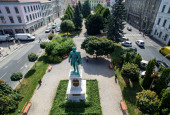Széchenyi Square
The square is named after the first honorary citizen of Sopron, Count István Széchenyi.
He initiated to drain the double pond that had fed the moat of the castle since the Middle Ages. Originally, there was a double pond on the square, called the Two Bakers' Pond, where bakers who sold bread of insufficient size and weight were bathed. The ponds were drained, and the square began to be built from 1828, and by the mid-19th century the town's first pedestrian square was created here. In the second half of the 19th century, after the demolition of the city walls and the attached Italian bastion, new buildings were built in the northern half of the square, the neo-Gothic ones were designed by Nándor Handler, Sopron's outstanding 19th-century architect.
The oldest building in the square is the two-towered Baroque Church of St. Dominic. Other characteristic buildings are: The Széchenyi Palace, the Art Nouveau Postal Palace and the Berzsenyi Dániel Lutheran Lyceum, the second oldest school in Hungary. The square's distinctive monuments are the Flag of Allegiance, inaugurated in 1932, and the monument erected in 2016 to commemorate the 60th anniversary of the 1956 Revolution and War of Independence. On either side of the monument, there are engraved figures of peaceful people. The holes in the sides represent the bullet holes of gunfire from the dramatic volley fires in the area (e.g. the Mosonmagyaróvár volley fire).
In 2016, on the 60th anniversary of the 1956 Revolution and War of Independence, the municipality erected a monument. On both sides of the monument there are engraved figures of peaceful people, the bullet holes are traces of shots that symbolize the dramatic volley-firings in the area.


